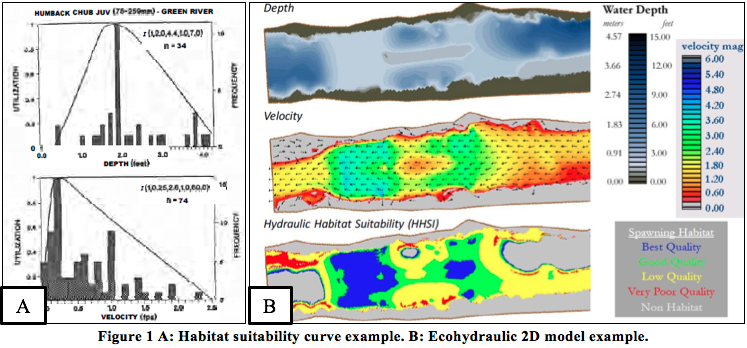Glen Canyon Dam (GCD) and the humpback chub (Gila cypha) are not friends, but they are on their way to at least subsist in the same place. The humpback chub (HBC) is an endangered species of fish that due to its past abundance, serves as an indicator of environmental conditions of the Colorado River, in particular for the Grand Canyon Reach. Protecting the HBC is about the recovery of an entire ecosystem and not just a funny-looking fish. While it is established that (GCD) affected our endangered friend, not much explanation is out for general public understanding besides the modified river flow. Is this information classified? No, it is just hard to explain sometimes. One of the sciences that study how aquatic species (mainly fish) is related to the form of the river and the physical properties of the water is Ecohydraulics. This discipline studies the link between ecology and hydraulics, and one of its tools is ecohydraulic modeling, which is used to explore and understand how different river variables that are usually modified by dams (form, depth, velocity, temperature, sediments, and nutrients) affect fish behavior, growth rate, and spawning. In the Grand Canyon reach, understanding of this relationship is essential for successful habitat restoration projects, specifically by regulating GCD hydropower flow releases.
In the 1980’s, scientists identified fish preferences for a particular flow velocity by observing where the fish spent more time, and recording the velocity at that particular location. They developed Habitat Suitability Curves (HSC) (Figure 1A) for different fish species to illustrate the relationship of river physical parameters and the probability of finding an area suitable for fish activities (i.e. spawning). Later, with new technologies and computational capacities, scientist applied findings from HSC to 2D model to calculate a Hydraulic Habitat Suitability Index (HHSI) as a value to compare different river characteristics and their relationship with fish (Figure 1B).

On the Grand Canyon Reach, the focus of ecohydraulic studies is on the HBC. Since GCD closure on 1963, the habitat suitability analysis is divided into three periods: (1) the period of no action from 1963 to 1990, (2) interim flows from 1991-1995, and (3) the current period of modified low fluctuating flows, which started in 1996. The first period is driven by highly daily fluctuations of hydropower production (<864m3/s) that eroded fish habitat downstream of GCD and modified the depth and velocity of the river. During this period, there was no persistently suitable habitat for fish during the day and the minimum flow requirement was low (25m3/s). The second is an interim period that established maximum daily flow fluctuations (141m3/s during day and 170m3/s during the night). The last period started the same year as the High Flow Experiments and redefined the maximum daily fluctuation (170m3/s). This period had a low summer steady flow experiment (226m3/s during four months) (2000) at a cost of $21 million in purchased power with no significant results due to its lack of follow-up.
Scientists have learned that low-steady flows are crucial for providing fish habitat. These flows are commonly formed by sandbars, as the water reduces its speed near the shore and creates shallow water habitat for juvenile fish. Hydropower peaking reduces or eliminates persistent habitat, which means that the number of places for fish to stay in peace and have a rest for a day are limited. Continuing scientific studies are GCD releases re-operations are vital for restoration activities in the Grand Canyon reach.
Most of the current ecohydraulic models consider water depth and velocity, but temperature and sediment need to be included for improving understanding of fish dynamics. Is the evolution of ecohydraulics the answer for fish habitat restoration?
